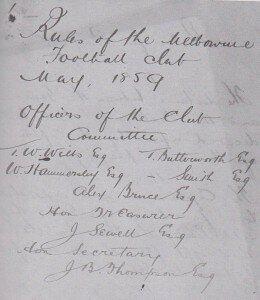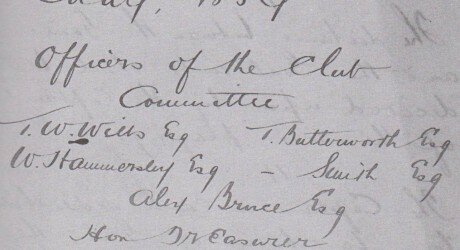A heterodox suggestion about the origins of football in Victoria
Roy Hay
(This article first appeared in the Almanac on 3 April 2015 at http://www.footyalmanac.com.au/a-heterodox-suggestion-about-the-origins-of-football-in-victoria/ )
As the 2015 football season kicks off, I am ruminating about how it all started way back in the mid-nineteenth century.
Perhaps we will never know what, if any, were the connections between the games played by indigenous inhabitants of Victoria and the game for which a group of recent migrants and English-educated ‘currency lads’ drew up sets of rules in the late 1850s. We do know for certain that Aboriginal people played a variety of games involving ‘balls’ and feet and hands. Unfortunately all the extant descriptions in print come from the European migrants, as far as I know. There are Aboriginal oral traditions that give us tantalising hints about games that have been handed down through families and groups. Inevitably these are now a mixture of ancient lore and more modern interpolations, as is the case in the oral history of other communities. Much of what we call history today has similar elements, overlaid by a striving after ‘scientific’ certitude that is never attained.
In my own research I have found multiple examples of football being played by British migrants all over Australia long before the codification of either Association football or the Victorian game. Many of those were small-sided, predominantly kicking games played for money or other prizes and hence according to some rules—rules that must have existed given that money was at stake. They were probably very simple, more like the rules we adopted in the playground at school, not a code to determine the future of a distinct form but something to fit the specific circumstances of the day or event. Everybody seems to have known what was going on, since very few reports or advertisements thought to spell out what football was. Colleagues in the United Kingdom and the United States report a similar pattern.
British people seem to have had a propensity to form clubs and associations independent of the governing body of the state in which they find themselves, whereas nineteenth-century continental Europe governments were very leery of intermediate bodies between themselves and their citizens. Here in Victoria, the first settlers appear in the 1830s and within a few years they have established the Melbourne Club, a Chamber of Commerce, a Caledonian Society, and the Melbourne Cricket Club, the Victoria Turf Club and more. Overlapping memberships ensure that there is a rapid circulation of ideas and a common desire to civilise and control the activities in which they engaged. So the group including Tom Wills, J B Thompson, William Hammersley, Alex Bruce, T Butterworth, J Sewell and Thomas Smith, whose names appear on the set of rules dated May 1859, were just doing what Brits were doing all over the globe and at home. They went through the rules of the public schools and universities they had attended and made up a composite set that were quite like the ones the Football Association in England adopted in 1863 or the ones that a group of students and town boys in Hartford Connecticut in the USA drew up for their game on 8 November 1858.

The first page of the first extant set of rules of the Melbourne Football Club. The original is in the Melbourne Cricket Club Museum.
Hartford, Connecticut rules, November 1858
(1) Each side shall choose two umpires, whose decision, under the following rules shall be final.
(2) A line shall be drawn at 50 feet from either bound, over which lines the sides shall not pass before the ball has been canted.
(3) There shall be no carrying of the ball.
(4) A clear space of at least ten feet shall be given in front of the ball after it has been caught.
(5) Fifteen minutes shall be allowed between each game.
(6) Players shall, under no circumstances, be allowed to hold on to one of the opposite party.
(7) Each must keep on their own side of the ball.
(8) If the ball goes over the side bounds, it shall be kicked through the middle by the player who gets it.
This set of rules corresponds quite closely with that drawn up in London in 1863, with its version of offside and the ban on carrying the ball or holding an opponent. It indicates that where necessary written rules were supplied and enforced, in this case by four umpires.
So what happened in Melbourne and later more broadly in Victoria and eventually Australia was part of an exercise going on elsewhere even though there was to be much division into separate and distinct codes of football as the games evolved.
Let’s get back to one of the key figures in the early game, one Tom Wills. By now just about everybody agrees he was no administrator but a huge influence on the way the game was played on the field. None of his innovations seems to bear any relationship to any of the Aboriginal games that we know anything about.
Wills always looked upon himself as an upholder of the amateur tradition but like an equally influential English cricketer, Dr W G Grace, he found that was not incompatible with obtaining an income or some subsidisation for playing the games of cricket and football. In November 1866 he was employed to go to Lake Wallace in the Western District of Victoria to coach an Aboriginal cricket team that was slated to play the might of the Melbourne Cricket Club at the instigation of the groundsman of the latter club, Roland Newbury. Wills spent a month in the area that was close to where he grew up on the other side of the Grampians near Lexington.
I have no doubt that Wills spent much of his time coaching the indigenous players on the finer points of cricket but I suspect that, like all good coaches, he introduced a bit of variety into their training sessions, on and off the field. I can easily visualise him producing a football and having a scratch match at the game he played in the winter. It is not something he would record in his letters since that was not part of his remit. So perhaps we should reverse the popular notion that the indigenous folks in the Western District introduced a young Tom Wills to football and argue rather that the mature Tom Wills taught his local charges in 1866 to play the game.
There is one more piece of intriguing circumstantial evidence. The Lake Wallace lads took on and beat the men of Hamilton at cricket using their Wills-inspired competence in the game. But when the Aboriginal cricket team set off on the first leg of the journey that would take them to England in 1868 they stopped at Hamilton on the way. At that point some of the Hamilton cricketers came to their hotel and challenged them to a game of football. It is reported that the cricketers refused, saying the men of Hamilton had ignored their offer of a return game at cricket so that the latter could regain the laurels they had lost in the previous defeat. I suspect the Hamilton men thought they could get their own back by roughing up the ‘blacks’ at football rather than risk another defeat at cricket. I also suspect that the tour organisers and perhaps the Aboriginal players themselves thought the risk was too great to run given the arduous tour that lay ahead. That rather than the other reported explanation of lack of time seems quite plausible.
There are far too many imponderables in my story and I keep digging hoping to come up with some contemporary evidence, but as the footy season gets under way in 2015, I just wonder if we have the tale of the links between Aboriginal activities, including their ball games, and those of the Europeans the wrong way round.








Marnie Haig-Muir: Your review of the latest Rankin is right on the money, Roy. This book...